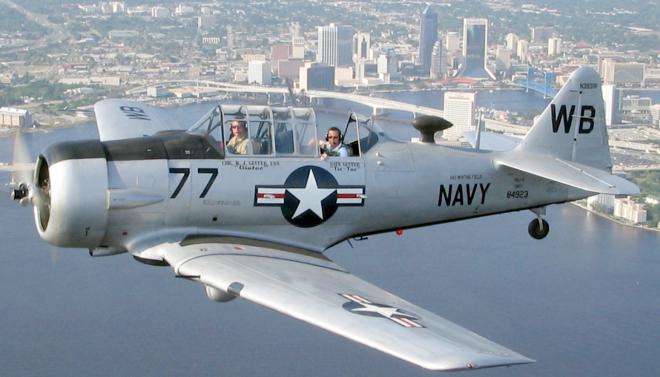This week’s plane of the week is the North American T-6 Texan.

The North American Aviation T-6 Texan is a single-engined advanced trainer aircraft used to train pilots of the United States Army Air Forces, United States Navy, Royal Air Force and other air forces of the British Commonwealth during World War II and into the 1970s. It remains a popular warbird aircraft used for airshow demonstrations and static displays. It has also been used many times to simulate the Japanese Mitsubishi Zero in movies depicting World War II in the Pacific.

The North American T-6 Texan was known as “the pilot maker” because of its important role in preparing pilots for combat. Derived from the 1935 North American NA-16 prototype, a cantilever low-wing two-seat monoplane, the Texan filled the need for a basic combat trainer during WW II and beyond. The original order of 94 AT-6 Texans differed little from subsequent versions such as the AT-6A which revised the fuel tanks or the AT-6D and AT-6F that strengthened and lightened the frame. North American’s rapid production of the T-6 Texan coincided with the wartime expansion of the United States air war commitment. As of 1940, the required flights hours for combat pilots earning their wings had been cut to just 200 during a shortened training period of seven months. Of those hours, 75 were logged in the AT-6.

The Texan originated from the North American NA-16 prototype (first flown on April 1, 1935) which, modified as the NA-26, was submitted as an entry for a USAAC “Basic Combat” aircraft competition in March, 1937. The first model went in to production and 180 were supplied to the USAAC as the BC-1 and 400 to the RAF as the Harvard I. The US Navy received 16 modified aircraft, designated the SNJ-1, and a further 61 as the SNJ-2 with a different engine.

A further 92 BC-1A and three BC-2 aircraft were built before the shift to the “advanced trainer” designation, AT-6, which was equivalent to the BC-1A. The differences between the AT-6 and the BC-1 were new outer wing panels with a swept forward trailing edge, squared-off wingtips and a triangular rudder, producing the definitive Texan appearance. After a change to the rear of the canopy, the AT-6 was designated the Harvard II for RAF/RCAF orders and 1,173 were supplied by purchase or Lend Lease, mostly operating in Canada as part of the Empire Air Training Scheme.

In Canada it was known as the Yale and in the UK it was named the Harvard. I find it pretty clever of them to name an American plane after American universities.

The T-6 was used by 55 air forces around the world as a trainer and is now used as a racer, show plane, and civilian trainer and is easily one of the most popular trainers ever built. It was so popular that Beechcraft later made a trainer and named it the T-6 Texan II.

Next Week: Binge-reading on North American Aviation.
